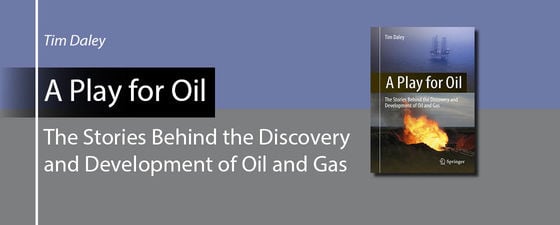“A Play for Oil: The Stories Behind the Discovery and Development of Oil and Gas” by Tim Daley. Springer, 2018.
The History of Oil Exploration
A Play for Oil: The Stories Behind the Discovery and Development of Oil and Gas
This autobiography of a geoscientist is a very well-constructed and exciting review of the oil exploration industry over the past four decades.
It starts as it means to continue with descriptions of the fun involved in taking part in undergraduate field trips to undertake surface geological mapping in Spain. Thereafter, we are reminded that hydrocarbons are discovered by figuring out where the sedimentary reservoir rocks might be located, under land or ocean, together with their source rocks and the hydrocarbon trapping process. Enhancing these fundamental principles, however, Tim emphasizes the necessity of collecting and interpreting seismic data, in order to locate prospective reservoirs and drill them. Therefore, from this point early in the book, he always describes himself as a ‘seismic interpreter’.
The Author
After Spain Tim Daley graduated from Oxford, progressed to a Masters in Geophysics at Durham University and started work with Esso in Esher in Surrey in the UK in the early 1980s. His later employers included UK independent Lasmo, as well as ENI and BG. Much time was spent in remote locations in Asia, Africa and Latin America.
What’s in it for the Reader?
The reader is presented with basic information on the various technologies involved in the process of prospecting, drilling and testing for oil and gas. Naturally, there are several pages describing the seismic acquisition process and, unsurprisingly, an entire chapter on seismic interpretation. However, this technical content is not too scary, with good simple diagrams to assist our understanding.
The transformation of technology from analog to digital is also emphasized, which not only made the move from 2D to 3D seismic possible, but also brought about the luxury of doing seismic interpretation on individual desktops. Do we have smartphone seismic yet?
Keeping it Light
However, the magic of this book is its humanity. The geophysics world can be a bit awesome with its mega-computing physics speak, its massive seismic boats and huge, all-terrain trucks, but related stories from Blackpool to Balikpapan keep our feet firmly grounded. The mysterious whisky bottle in the violin case, crossing the Danube to Romania; the all-terrain taxi in Ecuador; and the cocktail and beer parties in remote areas of Pakistan and Borneo all remind us that this serious business has its lighter moments.
In Chapter 8 our hydrocarbon ‘seismic interpreter’ reveals his concern for communities through his involvement in trying to establish whether high pressure fracking in Oklahoma and Lancashire is causing earthquakes. He wonders how ‘nimbyism’ can be satisfied when we have movies apparently showing flaming faucets?
Spending a summer in the Karachaganak field in Western Kazakhstan, he speculates that the rolling steppes are to a certain extent protected by the dangers of the oil and gas operation. The hydrocarbons being produced are contaminated with highly poisonous hydrogen sulfide gas, which means that the whole production area is treated as an exclusion zone. The resultant barring of the population at large has therefore created a protected wildlife habitat. It is at this point that this geoscientist reveals his interest in bird watching as well as rocks, and proves he is very knowledgeable on the topic.
The final chapter reminds us that the oil and gas industry exists because the world’s population demands the luxury and convenience that hydrocarbons provide. We shall replace it with alternative energy sources given time, but until then it is good to be reminded of the work and effort undertaken in the search for oil throughout the world.
Conclusion
Tim should be proud of providing us with this honest, informative and exciting read, which I note has a Library of Congress reference. It should be in every library and we readers should also spread the word.





